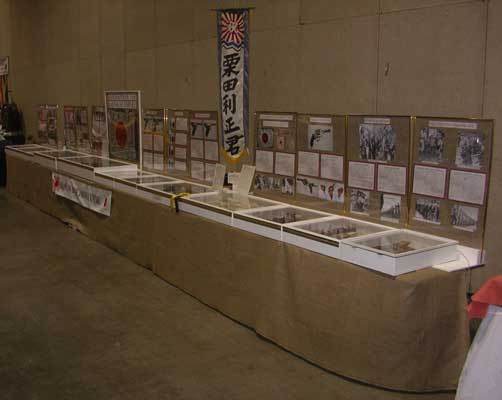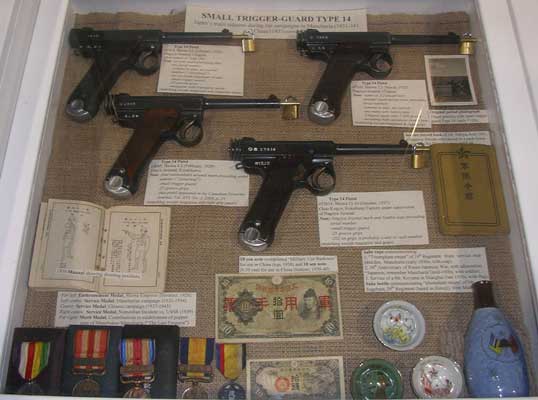Nambu World: 2007
What is
believed to be the largest gun show in
Here is an overall view of the display. It was 32 feet long (four 8-foot tables). The display panels with explanatory background are the same as in previous displays shown on the site (see the Calgary 2006 display page, for example), so here I will just show what was in the cases and comment on what was different from last year’s Calgary Show. I had a good spot just inside the entrance. The display is arranged chronologically from right to left rather than left to right in order to match the direction of the visitor traffic flow.

I had to reduce the size of the case
of reservists’ items to this 18” case (my smallest) so I could use the 24” case
I used last year to expand my presentation of Type 94 pistols.

Here are items from the women’s and youth’s
organizations that helped organize send-off parades and other support
activities for the soldiers.

New in this Type 26 display case is
the metal Russo-Japanese War sake cup in the upper left. It was part of a
four-item set of things from one soldier (along with his service medal and
certificate and his service record book).

The main change in this case was the
unusual imonbukuro
(comfort bag) in the lower left, second from the corner. This white,
hand-lettered bag says imonbukuro
on one side and maporu bukkyo nichiyo gakko (Marpole Buddhist Sunday School) on the other. Marpole is a district in the south part of

In this case I added a Japanese WWI Victory
medal. Unlike other countries’ WWI victory medals, this one does not portray
winged Victory on the front, as this Western mythological figure would have had
no significance to the Japanese. Instead, it portrays the Japanese mythological
figure Take-mikazuchi-no-kami, one of the eight sons
of the god Izanagi, who played a key role in

In this case my innovation was to
use a tray that was pre-labeled so I did not have to arrange each cartridge
individually. Besides several more sectioned cartridges in the tray, this case
contained an older style of Type 14 8mm Nambu
cartridge box in the upper right (third item from top). The older boxes have
more extensive labeling on the bottom.

This case had the biggest changes of
any, although it may not be immediately apparent. The top two pistols are new
this year. Both were made by the Chigusa factory of
Nagoya Arsenal, the first maker of Type 14s. One is dated 3,2 (February, 1928,
the 16th month of production) and the other is dated 7,3. These are
very rare, as the Chigusa factory only made 7,800
pistols. There were two main variations of markings, and these two pistols
represent one of each. In the bottom centre of the
case the right-most medal is also a new addition, a Manchurian National
Foundation merit medal. I think it is one of the most attractive medals in my
collection.

The early leather holster variations for the
Type 14 are shown here.

Here are the later leather variations.

This case shows the rubberized
canvas holsters for the Type 14. The holster in the upper right was a major
addition this year: it is a transitional holster with rubberized canvas body
and leather clamshell flap.

The left side of the case has other
field equipment like a mess kit, water bottle and bugle. Someone must have
bumped the case just before I took the picture. This is a continual problem as
I am always straightening things. It is a good thing I have everything under
plexiglass, as visitors are really quite careless in leaning on the cases.

Large trigger guard Type 14s from
the company established by Kijiro Nambu
himself. No major changes here, although at the show I made a major pistol
purchase from an estate that will allow me to upgrade a couple of these
specimens next time I do this display.

I had to squeeze one extra pistol into
this case of Toriimatsu Type 14s. The newcomer is in
the upper right: an 18.12 dated pistol. It is one of the first 8,000 in the
Second Series that retained the First Series appearance (grooved cocking knob).

I had to expand this case and use a
24” rather than last year’s 18” because of several additions over last year’s

Here is me with my “Best in
Show-Militaria” award plaque and a cheque for C$300
(about US$250). Second prize in this category went to a display on

Here is a close-up of the plaque. They will
send me a little brass plate with my name on it to affix in the empty area
below “

This display of Canadian war posters
won first prize in the Historical category. Second prize went to a display on
the Pacific Coast Militia Rangers, a unit formed in 1942 in British Columbia to
patrol against possible Japanese invasion (I have a small section on this unit
at Nambu
World: Pacific Coast Militia Rangers (PCMR)).

This display of Winchester Model 69s won in the
civilian “Arms” category. Second prize went to a display of Remington rolling
blocks.

Quite apart from the award I won,
this was a very good show for me in terms of acquisitions and networking for
future deals. Next year I will probably do a smaller, two-table display
including an overview of Japanese pistols, rifles and bayonets rather than this
very in-depth presentation of Japanese handguns. The reason is that the couple
who have done the bulk of the work in organizing the show for many years will
be retiring from that role and a group that includes me has agreed to take
over. That means I will be helping with the running of the show and so I won’t
have the time to erect such a large display. It took me about six hours to set
up and the tear-down took about two and a half hours even with my husband’s help.
Over the next year I will be working on a smaller display that is quicker to
set up and that can therefore also be used for one-day shows.
Click here to go back to Nambu
World: Teri’s WWII Japanese Handgun home page: Nambu World: Teri’s
WWII Japanese Handgun Website
Last updated: April 15, 2007. All contents are copyright Teri unless otherwise specified and
may not be used elsewhere in any form without prior permission.